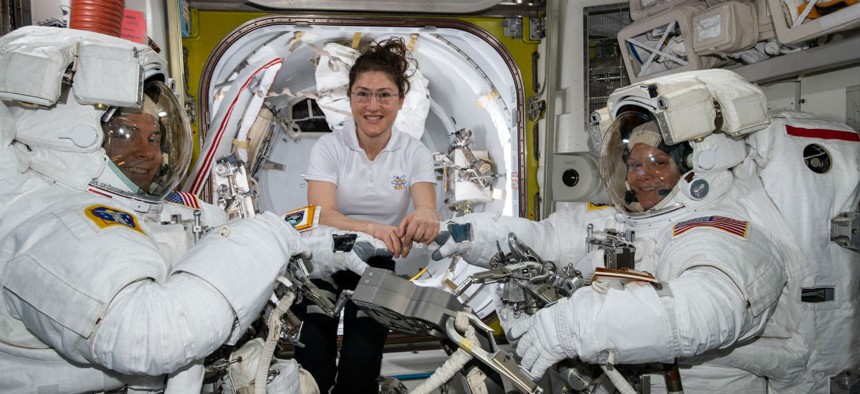The Original Sin of NASA Space Suits

NASA astronaut Christina Koch (center) assists fellow astronauts Nick Hague (left) and Anne McClain in their U.S. spacesuits shortly before they begin the first spacewalk of their careers. NASA
They were never designed to fit everyone.
The crew of the International Space Station spends most of their time inside, but sometimes they venture out. Astronauts have conducted more than 200 spacewalks in the last two decades, often to spruce up the station, and on the next one, two astronauts are scheduled to replace some old solar panel batteries. It was going to be a historic excursion: For the first time in history, both of the spacewalkers would be women.
That was the plan. But on Monday, just days before Anne McClain and Christina Koch were supposed to float outside, NASA announced that McClain has been replaced with a male astronaut, Nick Hague. According to the space agency, the ISS doesn’t have enough spacesuits on board that would fit both women.
At first glance, this seems like a massive oversight. Shouldn’t NASA have figured out which size spacesuit their astronauts needed before they launched, and had appropriate gear waiting for them on the ISS? And how is it that the world’s premier space agency can dress two men for spacewalks without issue, as it did several times last year, but not two women?
To answer these questions, it helps to start at the beginning. Not the Big Bang—we’ll save that for another day—but the 1960s, when NASA first started launching astronauts to space.
Back then, women weren’t wearing spacesuits, they were making them. The Apollo spacesuits were manufactured by the International Latex Corporation, the maker of Playtex bras and girdles. Seamstresses went from sewing undergarments to stitching together thin layers of high-tech fabric on their noisy Singer sewing machines. The spacesuits were custom-made for individual astronauts, all of whom were men.
After astronauts planted the American flag on the moon, NASA turned its focus toward the next phase in space travel, the Space Shuttle program. The shuttles were designed for a future of frequent flights to and from the space above Earth, with more astronauts than ever before.
Tailoring custom spacesuits for so many passengers would be too expensive and time-consuming. So in the 1970s, NASA took a Mr. Potato Head approach and developed pieces for arms, legs, and torsos that astronauts could mix and match. The spacewalking suit—known as extravehicular mobility units, or EMUs—came in five sizes: extra small, small, medium, large, and extra large.
When NASA started accepting women into its astronaut program in 1978, spacesuit engineers thought outfitting the new space travelers would be simple. “Some groups initially assumed that women could fit in the same sizes as small men—or at worst, that some of the men’s sizes would have to be scaled down proportionately to fit women,” Elizabeth Benson, a NASA design engineer, wrote in a 2009 paper on sizing considerations in spacesuit design.
This approach doesn’t account for differences in body shape of men and women. “For the same height and weight, women can have significantly wider hips and narrower shoulders than men,” Benson wrote. “If, for example, a one-piece coverall designed for a man is meant to fit at the shoulders and the hips, then one of these fit areas is likely to be compromised for a woman.”
Extra room can actually make spacewalks more difficult. “As a woman, doing spacewalks is more challenging mostly because the suits are sized bigger than the average female,” Peggy Whitson, a NASA astronaut who helped build the ISS and holds the American record for time spent in space, said in a recent documentary interview. And Whitson would know: she also holds the record for the most spacewalks for a female astronaut, 10.
In the 1990s, several years after the first American women flew to space, budget cuts forced NASA to trim its spacesuit program. Extra small was the first to go, and small followed soon after. Most astronauts fit into the mediums and larges, but not all.
"People my size are in fourth grade. Literally, I mean, some fourth graders are bigger than me,” Nancy Currie, a NASA astronaut who is five feet tall, told NPR in a 2006 interview back then.
The limited sizing affected some astronaut duties. While it didn’t impact Space Shuttle crew assignments, since crew members who didn’t spacewalk, like Currie, could do research or run the robotic arm, “it did impact assignments on the ISS where all crew members—Russian and U.S.—had to be able to conduct [spacewalks],” says Bonnie Dunbar, a former NASA astronaut who flew on the shuttle five times, and an aerospace engineering professor at Texas A&M University, where she runs a spacesuit-design lab.
The restrictions piled up after the Space Shuttles program ended in 2011, and the ISS became the only destination for astronauts. NASA was forced to judge prospective astronauts not only by their qualifications and experience, but their size, too. “Applicants had to be bigger to be selected,” Dunbar says. (The agency faced a similar situation in the 1960s, with the opposite problem: the first space capsules, tiny and cramped, required astronauts to be no taller than 5 feet 11 inches.)
Today, astronauts still use the same 40-year-old spacesuits; NASA hasn’t made any new ones since these were designed. Several have been lost over the years, including in the Challenger and Columbia disasters, and in a SpaceX cargo mission that exploded in 2015.
“We have to make do with what we have,” Dunbar says.
So what do we have, specifically on the ISS?
The station currently has six people on board. Their spacesuit wardrobe contains six spacesuit torsos, two each in medium, large, and extra large. But only some are ready for spacewalks; one medium and one extra large are spares, and require hours of work to prep for use, according to NASA spokesperson Brandi Dean. McClain trained on the ground in both the medium and large, but she wore the medium torso on a spacewalk with Hague last week. When she came back inside, she told mission control that the medium fit her better—the same size that her fellow female astronaut, Koch, planned to use.
“We do our best to anticipate the spacesuit sizes that each astronaut will need, based on the spacesuit size they wore in training on the ground, and in some cases—including Anne’s—astronauts train in multiple sizes,” Dean says. “However, individuals’ sizing needs may change when they are on orbit, in response to the changes living in microgravity can bring about in a body. In addition, no one training environment can fully simulate performing a spacewalk in microgravity, and an individual may find that their sizing preferences change in space.”
Instead of adapting the spare, NASA decided to change the spacewalk lineup. Koch will wear the medium torso on Friday’s spacewalk, and McClain will wear it again on another spacewalk, scheduled for early April.
The space agency is long overdue for new spacesuits, but it has hesitated, thanks to budgetary restrictions and changing policies. Medium or large, the garments “have far outlasted their original 15-year design life,” according to a 2017 report from NASA’s inspector general. In the last decade, NASA has spent nearly $200 million on spacesuit development for future missions, including to Mars, but “the agency remains years away from having a flight-ready spacesuit capable of replacing the EMU or suitable for use on future exploration missions,” the report found.
Some of the stagnation stems from uncertainty over where NASA will send future astronauts. The moon and Mars are different worlds, with their own environmental conditions, and require different spacesuit designs to keep humans healthy and alive. And it doesn’t help that the preferred destination seems to change with each new presidential administration. “The lack of a formal plan and specific destinations for future missions has complicated spacesuit development,” the inspector general said.
NASA today is far more accommodating for female astronauts than it once was, and the agency employs more of them than before. Consider the 1980s, when engineers sheepishly asked Sally Ride whether 100 tampons were enough for her seven-day mission to orbit. But the spacesuits they wear today are a relic of that time, built with other bodies in mind. Yes, NASA has to work with what it has, but in 2019, it employs female astronauts and should anticipate more. It doesn't seem too much to ask to have enough spacesuits to fit them, too.
NEXT STORY: Quick Hits



